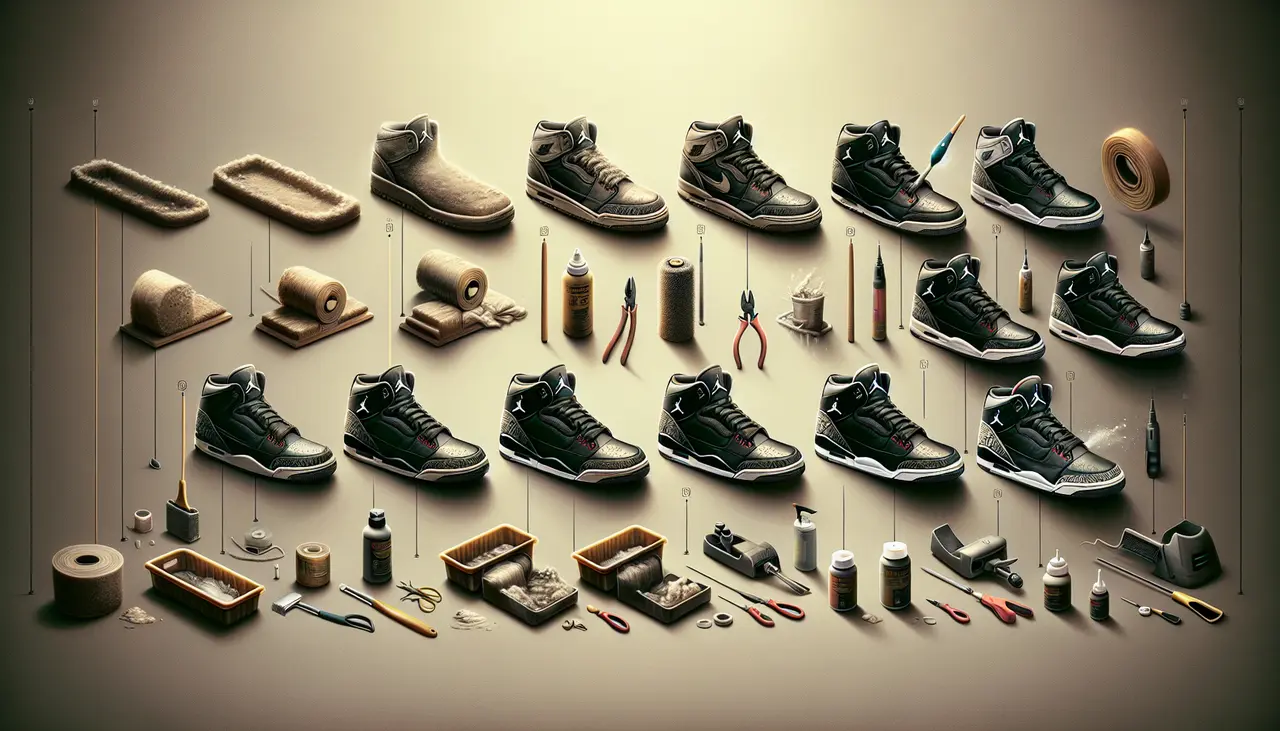The Evolution of Air Jordan Restoration Techniques: From Past to Present
Introduction to Air Jordan Restoration
Restoring Air Jordans is not just about making old sneakers look new again. It’s a craft. A skill that combines passion, precision, and a deep love for the game. Over the years, the techniques to bring these iconic shoes back to life have evolved. It started with simple cleaning methods, progressed to patching up minor wear and tears, and now, it’s an art that can completely transform a battered pair. Today, dedicated sneakerheads use a mix of traditional and innovative methods to tackle issues from yellowed soles to faded colors and everything in between. Each restoration project is a step towards preserving a piece of basketball and sneaker culture. Whether you’re a Jordan enthusiast looking to revive your old kicks or a newcomer curious about this unique blend of art and sneakers, understanding the basics of Air Jordan restoration is the first step on a rewarding journey.
The Early Days of Air Jordan Restoration
Back in the day, fixing up a worn pair of Air Jordans was all about basic care. Fans of these iconic kicks would simply clean them with soap and water, maybe add a bit of shoe polish, and that was about it. It was a simpler time, without the fancy tools and materials we have now. The goal was just to make them look presentable again. People swapped tips and tricks among themselves, relying on word of mouth and whatever they could find at home. There wasn’t a big market for sneaker restoration, so sneakerheads had to be creative with what they had. This DIY spirit laid the foundation for the sophisticated methods we see today in Air Jordan restoration.
The Tools of the Trade: Then vs. Now
Back in the day, restoring Air Jordans was all about the basics. Enthusiasts worked with what they had, which often meant using household items like toothbrushes for scrubbing, cotton balls for dabbing on polish, and hairdryers to help reshape distorted shoes. It was more about improvisation and less about precision. Fast forward to now, and the game has completely changed. Today’s restorers have access to a plethora of specialized tools and products designed exclusively for sneaker restoration. Think ultrasonic cleaners that deep clean without damaging the materials, airbrush kits for that perfect color match, and conditioners that not only restore leather but help in preventing future degradation. The approach has shifted from just making do to ensuring longevity and maintaining the integrity of the sneaker’s original design. It’s fascinating to see how the dedication to preserving the legacy of Air Jordans has driven the evolution from simple DIY tricks to a professional and highly detailed craftsmanship that defines the restoration process today.
Techniques in the 90s: A Nostalgic Look Back
Back in the 90s, the game of restoring Air Jordans was way different than what it is today. People had to rely on more basic, hands-on techniques because the advanced materials and online tutorials we have now just weren’t available. Back then, if you wanted to bring your Jordans back to life, you were often working with a toothbrush, some soapy water, and a lot of elbow grease for cleaning. Fixing scuffs? Maybe you’d try a bit of nail polish remover for minor marks, but anything major meant getting creative with whatever paints matched best. Sole separation? That was a job for strong glues that could bond the rubber back to the shoe, but you’d be crossing your fingers it held up. The process was more art than science, requiring patience, a steady hand, and an eye for detail. It was about saving those iconic shoes and keeping them on the streets, not just making them look brand new. Nowadays, the approach is much more sophisticated, but there’s still something pretty cool about the old-school way of doing things with what you had.
The 2000s: Technological Advancements in Restoration
The 2000s marked a turning point in the Air Jordan restoration scene, thanks to a wave of technological advancements. This era introduced us to methods that were not just about fixing; they were about bringing these iconic shoes back to their former glory with precision. The use of digital tools and online tutorials became game-changers. Restorers started to leverage the internet to share knowledge and tips, creating a community of enthusiasts dedicated to preserving the legacy of Air Jordans. Techniques like deep cleaning with specialized solutions, repainting with color-matched paints, and even de-yellowing soles using UV light treatments became more refined and accessible. Additionally, the introduction of 3D printing allowed for the creation of hard-to-find replacement parts, making it possible to save even the most worn-out pairs. This period didn’t just revolutionize how people restored Air Jordans; it also fostered a global community focused on appreciating and preserving sneaker culture.
The Role of Social Media in Air Jordan Restoration Culture
Social media has changed the game for Air Jordan restoration. Back in the day, sneakerheads had to figure out restoration tricks through trial and error or word of mouth. Now, platforms like Instagram, YouTube, and Twitter are treasure troves of knowledge. Restoration artists showcase their work, share step-by-step guides, and connect with fans and clients alike. This exposure not only highlights the skill and creativity involved but also educates a broader audience on preserving these iconic shoes. As a result, we’ve seen a surge in appreciation for both the art of restoration and the storied history of Air Jordans themselves. In short, social media has transformed Air Jordan restoration from a niche hobby into a celebrated culture.
Professional vs. DIY Restoration: A Comparative Analysis
When it comes to bringing your Air Jordans back to their former glory, you’ve got two roads: hand them over to a pro or take the DIY route. Let’s break it down. Hiring a professional means your kicks get treated by someone with experience and the right tools. You’re looking at spending more, but the chances of a top-notch result are higher. They know the ins and outs, ensuring that materials and colors match perfectly. On the flip side, rolling up your sleeves and tackling the job yourself can be less heavy on the wallet. With countless tutorials out there, getting the know-how is easier than ever. However, brace yourself for a learning curve and the risk of not getting it quite right the first few tries. In essence, if perfection and time are your priorities, professionals are worth the dime. But, if you’re up for a challenge and keen to save some cash, DIY could be your jam.
Notable Air Jordan Restoration Projects and Their Impact
Restoring Air Jordans isn’t just about fixing them up; it’s about bringing a piece of history back to life. The sneaker community has seen some incredible restoration projects over the years, each highlighting the creative spirit and dedication of sneakerheads around the globe. One such project involved the Air Jordan 1 “Banned,” a sneaker famously outlawed by the NBA. Restorers managed to revive a battered pair, using period-accurate materials, ensuring the sneaker’s history was preserved along with its appearance. This project not only showcased the technical skills involved in sneaker restoration but also underscored the cultural significance of Air Jordans in sports history. Another noteworthy restoration was the Air Jordan 3 “Black Cement.” Known for its iconic design, this model had seen better days until restorers took on the challenge. They meticulously repaired the cracked midsoles, rejuvenated the faded leather, and even sourced original 1988 Air Jordan logos for the heel tabs. This level of detail in the restoration process made it a talking point in sneaker communities, emphasizing the importance of preserving the original aesthetics and materials of Air Jordans for future generations to admire. These projects, among others, have not only saved countless sneakers from being discarded but also elevated the art of sneaker restoration. They remind us that with the right skills, dedication, and respect for the heritage, it’s possible to breathe new life into even the most worn-out pair of Air Jordans, making their impact everlasting in the world of sneaker culture.
The Future of Air Jordan Restoration: Trends and Predictions
The future of Air Jordan restoration is looking bright, with new trends and predictions pointing towards a blend of technology and customization. Imagine this: using advanced 3D printing to replace worn-out parts, or even tailor-make unique colorways that were never released. Restoration experts are also experimenting with materials that are not just durable but can adapt to your foot’s shape over time, promising a personalized fit like never before. Sustainability is another big trend, with a shift towards eco-friendly materials and techniques that reduce waste and environmental impact. With these advancements, the goal is not just to restore Air Jordans to their former glory but to elevate them to something even better. Whether it’s for performance or style, the future of Air Jordan restoration is about making your sneakers more personal, sustainable, and innovative.
Conclusion: The Evolutionary Journey of Air Jordan Restoration
The journey of Air Jordan restoration has come a long way, evolving from simple DIY fixes to a complex craft using advanced technology. What started as sneaker enthusiasts using basic cleaning methods and paint touch-ups has transformed into a meticulous process involving sneaker restoration experts. These pros blend artistry with precision, employing techniques like deoxidation to restore the soles’ original color and re-gluing techniques that ensure longevity without compromising the sneaker’s integrity. The evolution reflects not just a change in methods but a deeper appreciation for preserving the legacy of Air Jordans. This journey shows us how passion combined with innovation can elevate sneaker restoration from a hobby to an art form, ensuring that Air Jordans continue to leave their mark, not just in sports, but as cultural icons.





Leave a comment